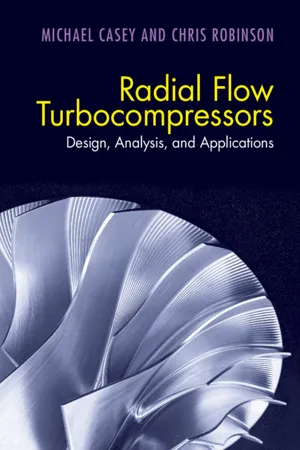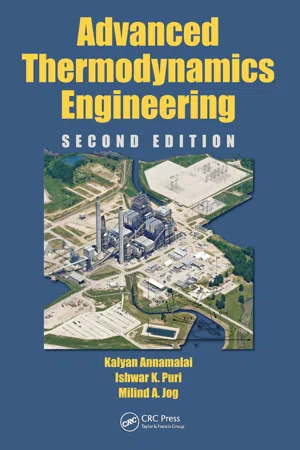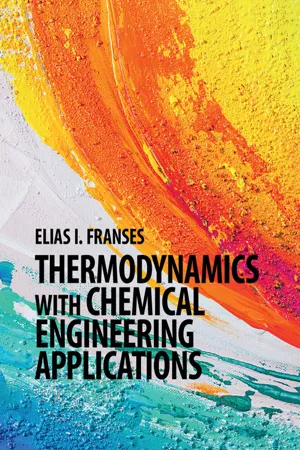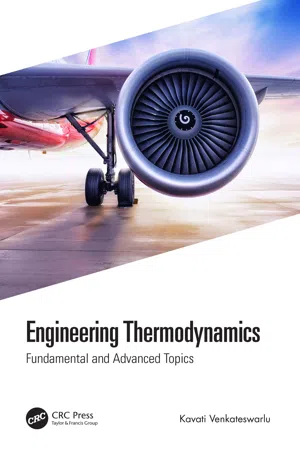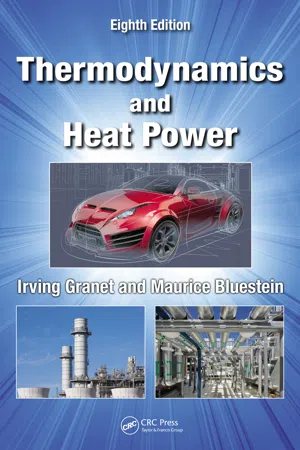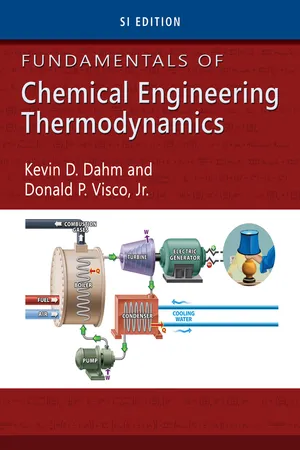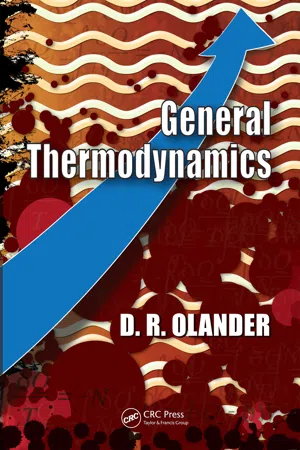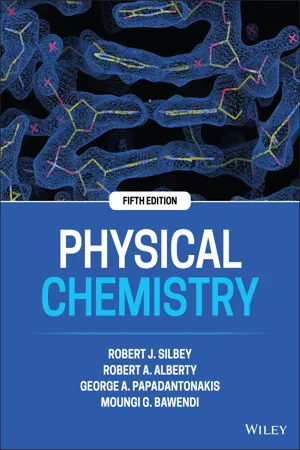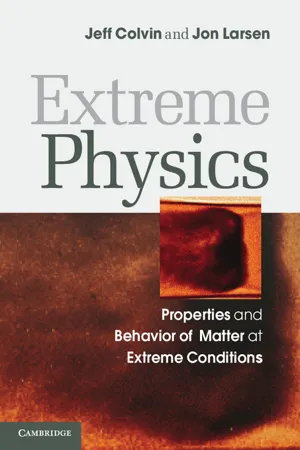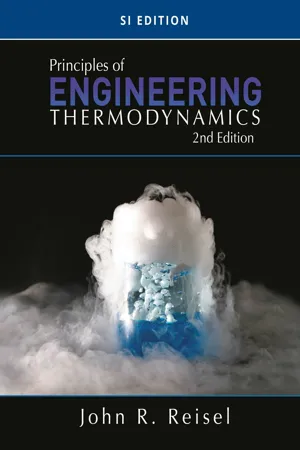Technology & Engineering
Equation of State of an Ideal Gas
The equation of state of an ideal gas is a mathematical relationship that describes the behavior of an ideal gas under different conditions of pressure, volume, and temperature. It is typically represented by the equation PV = nRT, where P is pressure, V is volume, n is the number of moles, R is the gas constant, and T is temperature. This equation helps to predict and understand the properties of ideal gases.
Written by Perlego with AI-assistance
Related key terms
1 of 5
12 Key excerpts on "Equation of State of an Ideal Gas"
- eBook - PDF
Radial Flow Turbocompressors
Design, Analysis, and Applications
- Michael Casey, Chris Robinson(Authors)
- 2021(Publication Date)
- Cambridge University Press(Publisher)
For most of the simplified considerations examined in this book, it is assumed that the equation of state can be represented either by the thermal and caloric equations of state for a perfect gas or by those for an incompressible fluid. The extension to real gases is given as separate sections where relevant. Lou et al. (2014) point out that even in compressor applications with air as the medium it is sometimes important to make use of real gas equations. It is important to remember that the equation of state defines the relations which exist between properties in a state of thermodynamic equilibrium. It should not be confused with a process equation, such as those for a polytropic or isentropic process, which define the compression path which the fluid takes between specific end states. Both the process equation and the equations of state hold at each point on this compression path. 3.2.2 Perfect Gas The thermal equation of state of a gas defines a functional relationship among the state variables of pressure, p, specific volume, v, and temperature, T, in the state of equilibrium. In 1662, Robert Boyle (1627–1691) discovered that the volume of a simple gas held at constant temperature was inversely proportional to the pressure (Boyle’s law). This law can also be derived from the kinetic theory of gases, following Jeans (1940) (James Jeans, 1877–1946). If a closed vessel containing a fixed number of molecules is reduced in volume, more molecules will strike a given area of the sides 88 Equations of State of the container per unit time, causing a greater pressure. In 1787, Jacques Charles (1746–1823) found that the volume of a simple gas at constant pressure was directly proportional to its absolute temperature (Charles’s law). This effect is caused by the kinetic energy of the molecules in the gas, which increases with temperature, causing an increase in volume at constant pressure. - eBook - PDF
- Kalyan Annamalai, Ishwar K. Puri, Milind A. Jog(Authors)
- 2011(Publication Date)
- CRC Press(Publisher)
Otherwise, the relations between these properties must be derived using physical principles. First, we will discuss the simplest equation of state (i.e., the ideal gas relation). This relation will be extended to consider real gases and other fluids in terms of two- and three-parameter equations of state. Finally, approximate equations of state for liquids and solids are discussed. THERMOLAB 306 ◾ Advanced Thermodynamics Engineering, Second Edition software is available to solve for v given P and T and vice versa for various state equations. (for which spreadsheet software is also available at www.crcpress.com, download and update page, Advanced Thermodynamics Engineering, download thermolab-1.zip) 6.2 Equations of State The ideal gas equation of state is also considered to be a thermally or mechanically perfect state equation. In Chapter 1 we presented a simple derivation of this equation by using microscopic thermodynamic considerations and neglecting intermolecular forces and the molecular body vol-ume. The resulting relation was Pv RT 0 = . (6.1) The subscript 0 in this chapter and Chapter 7 implies that the gas is ideal at the given conditions. If the measured gas volume at given P and T values is identical to that calculated by using Equation 6.1, the gas is said to be an ideal gas. However, if the measured specific volume at the same pres-sure and temperature differs from that determined using Equation 6.1, the gas is considered to be a real gas. If so, the actual specific volume v – (T, P) can be determined from experiments and tabulate them for many species of interest just like steam and R134a tables. However this requires tabulation of a vast amount of data for many species. A way to avoid tabulation is to the use com-pressibility factor Z, which is defined as Z(T, P) = v – (T, P)/v – 0 (T, P), (6.2) while v – 0 can be determined using ideal gas law. - Elias I. Franses(Author)
- 2014(Publication Date)
- Cambridge University Press(Publisher)
The data on equations of state are extremely important in thermodynamics. They are used in calculating work and heat requirements for physical and chemical processes. They are also used in the calculations of enthalpies, entropies, chemical potentials, fugacities, etc. (see Section 8.3 ). 5.2 THE IDEAL GAS EQUATION OF STATE AND ITS MOLECULAR INTERPRETATION ................................................................................................. The well-known equation of state for an ideal gas is p V ¼ RT : ð 5 : 11a Þ 5.2 The ideal gas equation of state 105 An equivalent way of expressing Eq. (5.11) for ideal gases, and for describing the extent of the deviation of the molar volumes of real, or nonideal, gases from Eq. (5.11a) is to de fi ne the dimensionless “ compressibility factor ” Z as follows: Z p V RT : ð 5 : 11b Þ The compressibility factor can be thought of as a dimensionless molar volume, or the ratio of the actual molar volume V T , p ð Þ divided by the ideal gas molar volume of V id ¼ RT = p . For an ideal gas, Eq. (5.11a) implies that Z ¼ 1.0. For a nonideal gas, Z 6 ¼ 1.0, and Z depends on T and p , or Z ¼ Z ( T , p ). In Eqs. (5.11), by T we mean the ideal gas temperature; see Section 3.12 . As shown later in Chapter 7 , this ideal gas temperature is equal (or proportional) to the absolute thermodynamic temperature, T . From now on, we will use this symbol T without making a distinction. Some gases, such as oxygen and nitrogen, behave ideally at room temperature and pressure. Some other gases or vapors behave nonideally at room temperature and pressure, and ideally at much higher temperatures or at much lower pressures. Strictly speaking, a gas behaves ideally for values of the dimensionless, or reduced, temperature T r much larger than 1, T r T / T c 1, or for dimensionless or reduced pressures p r much smaller than 1, or p r p / p c 1.- eBook - ePub
Engineering Thermodynamics
Fundamental and Advanced Topics
- Kavati Venkateswarlu(Author)
- 2020(Publication Date)
- CRC Press(Publisher)
8 Properties of Gases and Gas MixturesLearning Outcomes After learning this chapter, students should be able to- Explain the quantitative relationship between T, v, and P as described by the kinetic theory of gases and ideal gas models.
- Interpret the relationship between partial pressures and the total pressure as described in Dalton’s law of partial pressure.
- Determine the mole fractions of gases within and gas mixture and relate mole fraction to the partial pressure of a gas within a gas mixture.
- Explain the relationship between kinetic energy and temperature of a gas; between temperature and the velocity of a gas; and between molar mass and the velocity of a gas.
- Explain the deviation of ideal gas models with the behavior of real gases observed in nature.
- Explain the general principles of the hard-sphere model and the Van der Waals model of gas.
8.1 Ideal Gas Equation of State
Equation of State
It is defined as the functional relationship among the properties pressure p, specific volume ν, and temperature T, expressed as f(p,ν,T) = 0. The equation of state is useful for finding the properties of a gas; that is, if two of the properties are known, the third can be found. There are numerous equations of state, including simple and complex ones. The ideal gas equation of state is comparatively simple and it can accurately predict the behavior of substances in the gas phase.Robert Boyle proved experimentally that the pressure of gases is inversely proportional to their volume. Charles and Gay Lussac showed that the volume of a gas is directly proportional to its temperature at low pressures, which is expressed aswhich is an ideal gas equation of state. R is a characteristic gas constant; its value is different for different gases.p ν = RT(8.1) - No longer available |Learn more
- Irving Granet, Maurice Bluestein(Authors)
- 2014(Publication Date)
- CRC Press(Publisher)
The expressions ideal gas and perfect gas appear in many textbooks on thermodynam-ics, and unfortunately, some confusion has developed regarding the exact definition of these terms. For clarity and consistency, these terms will be given identical meanings and defined as gases having equations of state that correspond to Equation 6.7 or 6.8. 244 Thermodynamics and Heat Power 6.2 Basic Considerations The first observations concerning the equation of state of a gas were made by Robert Boyle (1629–1691), an English chemist, in the year 1662. He observed experimentally that the vol-ume of a given quantity of gas varies inversely with absolute pressure if the temperature of the gas is held constant. We can write Boyle’s law as p p V V p V p V 1 2 2 1 1 1 2 2 = = = or constant (6.1) Because T = constant, we can also write Equation 6.1 as pV = C (6.1a) where C represents a constant for a given temperature. A family of curves for different temperatures is shown in Figure 6.1. Each of these curves is an equilateral hyperbola, because they are of the form xy = C. p p 1 p 2 V 1 V 2 V 0 T a = constant T b = constant T c = constant 1 2 FIGURE 6.1 Boyle’s law. 245 The Ideal Gas ILLUSTRATIVE PROBLEM 6.1 A gas occupies a volume of 100 ft. 3 and is at a pressure of 100 psia. If the pressure is reduced to 30 psia, what volume will the gas occupy? Assume that the gas tempera-ture is kept constant. SOLUTION For a constant temperature process, Boyle’s law is p 1 V 1 = p 2 V 2 Therefore, V p p V 2 1 2 1 = and V 2 3 3 100 30 100 333 = = ( ) ft . f t. ILLUSTRATIVE PROBLEM 6.2 A gas occupies a volume of 2 m 3 at a pressure of 1 MPa. If the pressure is increased to 8 MPa, what volume will the gas occupy if the gas temperature is kept constant? SOLUTION For the constant-temperature process, we again have from Boyle’s law p 1 V 1 = p 2 V 2 and V p p V 2 1 2 1 6 6 3 3 10 8 10 2 0 25 = = × = ( ) . m m - Kevin Dahm, Donald Visco(Authors)
- 2014(Publication Date)
- Cengage Learning EMEA(Publisher)
289 7 Equations of State (EOS) C hapter 2 introduced the need for reliable models that provide estimates of physi-cal and thermochemical properties, for situations in which experimental data is not available. The models introduced at that time (e.g., ideal gas model) were simplistic, and valid only under specific conditions. Chapter 6 introduced a broader range of modeling techniques that are applicable to any pure compound at any conditions, but using them often requires an equation of state. In Chapter 2, we defined an “equation of state” (frequently abbreviated EOS) as a math-ematical relationship among P , V , and T , such that if any two are specified, the third can be calculated. So far, the only equations of state we have introduced are the ideal gas law and van der Waals. The motivational examples take a closer look at these and demonstrate the need for more versatile equations of state. Chapter 6 contained some additional equa-tions of state that were contrived by the authors for illustrative purposes but have never been used in engineering practice. 7.1 MOTIVATIONAL EXAMPLES : Transportation of Natural Gas Natural gas is a widely used fuel source, composed primarily of methane. Within the continental United States, it is most commonly transported by pipeline. However, when natural gas is shipped overseas, or to remote locations, an alternative to build-ing more pipelines is transporting it by ship. This involves liquefying the natural gas, so that it can be stored in small volumes for transport. Liquefied natural gas (LNG) is hazardous because it is flammable and also because of the extreme cold at which it must be maintained; typical temperatures would be in the vicinity of 110 K.- eBook - PDF
- Donald Olander(Author)
- 2007(Publication Date)
- CRC Press(Publisher)
49 2 Equations of State 2.1 WHAT IS AN EQUATION OF STATE? There are two types of equations of state , or EOS. In general, they are thermodynamic relationships between three properties of a pure (one-component) substance. In discussing the fundamental meaning of equations of state, it is useful to eliminate the quantity of the substance in order to deal only with intensive properties (see Section 1.6.2). Extensive properties can be converted to intensive properties by dividing the former by the quantity of the substance. (e.g., on a per-mole basis v = V / n , u = U / n ). The volumetric EOS refers to the relationship of the p -v -T properties of a gas. Solids and liquids are also described by p -v -T equations of state, although the quantitative forms are very different from those applicable to gases. In functional form, the volumetric EOS can be written as v = f ( p,T ), or v ( p,T ) for short. This form indicates that the specific volume (or molar volume) is expressed as a function of pressure and temperature. However, the EOS can be equally well written as p ( v,T ) or T ( p,v ). Because pressure and temperature are usually specified in an experiment or in a process, the form v ( p,T ) is most commonly employed. The EOS relating v , p , and T provides no information about the other thermo-dynamic properties, in particular about the internal energy u and the entropy s . However, according to the phase rule (Section 1.12), specifying any two properties of a pure substance fixes all properties. Nonetheless, the EOS in the form p ( T,V ), for example, gives no hint about the functions u ( T,v ), s ( T,v ), or of the remaining auxilliary properties h , f , and g (see Section 1.6.1). Knowledge of ( T,v ) requires information about the substance beyond that contained in its p -v -T relationship. Functional relationships such as u ( T,v ) are sometimes called thermal equations of state . - eBook - ePub
- J J Eldridge, Christopher A Tout;0(Authors)
- 2018(Publication Date)
- WSPC (EUROPE)(Publisher)
Chapter 3
The Equation of State
In most stars, the equation of state is not everywhere sufficiently simple that we may write pressure P = P(ρ) as a function of density ρ only. Generally we need two state variables, such as density and temperature T, and a description of the composition, such as the set of mass fractions XIt is often convenient to divide the pressure into contributions from the ions, electrons and radiation, but in a non-degenerate gas the electron contribution can be combined with the ion contribution in a single gas pressure,iof nuclide i. An equation of state might then be written in the form P = P(ρ, T, {Xi}). The first two equations of stellar structure (2.2) and (2.10) are no longer closed and we shall need to include two more, the equation of heat transport and the equation of energy generation that form the subjects of Chapters 4 and 6 .We begin our discussion with this case before examining the contribution of radiation, the importance of which increases with temperature. We then examine the quantum mechanical contribution of electron degeneracy, important in the dense material of the cores of giants and white dwarfs.3.1.Gas Pressure
Cool but sufficiently tenuous stellar material is usually well described simply as an ideal gas. This is a reasonably good approximation in the Sun and a very good one outside its relatively dense core and we can writewhere is the gas constant and μ is the mean molecular weight of the ions and electrons combined. The gas constantis the ratio of Boltzmann’s constant k to the atomic mass unit mH . One mole of hydrogen, or protons, has a mass very close to 1 g so in the form commonly used for stellar evolutiontoo. Formally mH is defined to be one-twelfth of the mass of a carbon-12 atom so that one mole of protons actually has a mass of 1.007 g. In our discussions in this chapter we shall ignore small differences from integer atomic masses to make the discussion simpler. They do not make very significant changes to the equation of state but should be taken properly into account in quantitative calculations. On the other hand the differences are essential when we consider nuclear fusion in Sec. 6.2 - eBook - PDF
- Robert J. Silbey, Robert A. Alberty, George A. Papadantonakis, Moungi G. Bawendi(Authors)
- 2021(Publication Date)
- Wiley(Publisher)
All gases show a minimum in the plot of compressibility factor versus pressure if temperature is low enough. Hydrogen and helium, which have very low boiling points, exhibit this minimum only at temperatures much below 0 ∘ C. A number of equations have been developed to represent P–V–T data for real gases. Such an equation is called an equation of state because it relates state properties for a substance at equilibrium. Equation 1.3 is the equation of state for an ideal gas. The first equation of state for real gases that we will discuss is closely related to the plots in Figs. 1.7 and 1.8, and is called the virial equation. In 1901 H. Kamerlingh-Onnes proposed an equation of state for real gases, which expresses the compressibility factor Z as a power series in 1∕ V for a pure gas: Z = P V RT = 1 + B V + C V 2 + · · · (1.11) The coefficients B and C are referred to as the second and third virial coefficients, respectively. ∗ For a particular gas these coefficients depend only on the temperature and not on the pressure. The word virial is derived from the Latin word for force. The second and third virial coefficients at 298.15 K are given in Table 1.1 for several gases. The vari- ation of the second virial coefficient with temperature is illustrated in Fig. 1.9. For many purposes, it is more convenient to use P as an independent variable and write the virial equation as Z = P V RT = 1 + B ′ P + C ′ P 2 + · · · (1.12) ∗ Statistical mechanics shows that the term B∕ V . arises from interactions involving two molecules, the C∕ V 2 term arises from interactions involving three molecules, etc. (Section 16.11). - eBook - PDF
Extreme Physics
Properties and Behavior of Matter at Extreme Conditions
- Jeff Colvin, Jon Larsen(Authors)
- 2013(Publication Date)
- Cambridge University Press(Publisher)
6 Equation of state As we learned in Chapter 4, the equations describing the motion of plasma are three equations that are derived from the laws of conservation of mass, momentum, and energy. These three equations express the four variables that describe the moving plasma – mass density, pressure, temperature (or energy), and velocity – as functions of spatial position and time. Since it is not possible to solve a system of three equations for four variables, we need a fourth equation relating some or all of these four variables that does not introduce another variable. The fourth equation is the equation of state. In the discussion that follows we will refer to the equation of state as the EOS. With the EOS specified, we can then solve the equations of motion for the plasma. We will learn how this solution is done numerically in Chapter 11. In this chapter we learn the basics of how to specify the EOS for matter at extreme conditions. 6.1 Basic thermodynamic relations We learned in Section 2.2.2 about the relaxation rates in dense plasma, that is, the rates at which thermodynamic equilibrium is established. In general, the variables characterizing the state of the plasma – mass density (or alternatively, particle number density), pressure, temperature – change slowly compared to these relax- ation rates. Thus, we can consider that the plasma is, at each point in space and at each instant of time, in local thermodynamic equilibrium (LTE). In LTE the particle distribution functions for each particle species comprising the plasma can be characterized by a single parameter, the temperature. Further, in the equilibrium plasma the laws of thermodynamics apply. In partic- ular, the thermodynamic free energy of the plasma can be written as F = −kT log Z, (6.1) 159 160 Equation of state where Z is the partition function, which describes how the energies are partitioned among the particles. - eBook - ePub
Compressors
Selection and Sizing
- Royce N. Brown(Author)
- 2011(Publication Date)
- Gulf Professional Publishing(Publisher)
2 Basic RelationshipsIntroduction
This chapter presents some basic thermodynamic relationships that apply to all compressors. Equations that apply to a particular type of compressor will be covered in the chapter addressing that compressor. In most cases, the derivations will not be presented, as these are available in the literature. The references given are one possible source for additional background information.The equations are presented in their primitive form to keep them more universal. Consistent units must be used, as appropriate, at the time of application. The example problems will include conversion values for the units presented. The symbol g will be used for the universal gravity constant to maintain open form to the units.Gas and Vapor
A gas is defined as the state of matter distinguished from solid and liquid states by very low density and viscosity, relatively great expansion and contraction with changes in pressure and temperature, and the ability to diffuse (readily distributing itself uniformly throughout any container).A vapor is defined as a substance that exists below its critical temperature and that may be liquefied by application of sufficient pressure. It may be defined more broadly as the gaseous state of any substance that is liquid or solid under ordinary conditions.Many of the common “gases” used in compressors for process plant service are actually vapors. In many cases, the material may change states during a portion of the compression cycle. Water is a good example, since a decrease in temperature at high pressure will cause a portion of the water to condense. This is a common occurrence in the first intercooler of a plant air compressor. Conversely, lowering the pressure in a reservoir of liquid refrigerant at a fixed temperature will cause the vapor quantity to increase.Perfect Gas Equation
Jacques A. C. Charles and Joseph Gay-Lussac, working independently, found that gas pressure varied with the absolute temperature. If the volume was maintained constant, the pressure would vary in proportion to the absolute temperature [4] - John Reisel(Author)
- 2021(Publication Date)
- Cengage Learning EMEA(Publisher)
89 3.5 Equations of State for Ideal Gases where a and b are constants particular to a specific gas. This model improves the ideal gas model by (a) accounting for intermolecular forces through the ayv 2 term and (b) accounting for the gas molecules occupying a finite volume through the b term. The need for this latter term is particularly straightforward to understand; clearly a molecule cannot occupy the space filled by another molecule, and so that volume should not be available for it to occupy. The use of the intermolecular force correction was a result of the recognition that gases do condense to liquids, which requires a force to draw molecules together. The constants a and b can be determined through values at the critical point. At the criti- cal point, the line of the critical temperature on a P-v diagram reaches a horizontal inflection point, and so the first and second derivatives of the pressure with respect to volume must be 0. As such, it can be found that a 5 27R 2 T 2 c 64P c and b 5 RT c 8P c (3.23) The difference that can be experienced in a prediction of v between the van der Waals equa- tion and the ideal gas equation is shown in Figure 3.16, where the value of v for oxygen is plotted as a function of temperature for three pressures, using both Eq. (3.22) and Eq. (3.12b). c EXAMPLE 3.8 Determine the specific volume of O 2 at 250 K and 2500 kPa using (a) the ideal gas law, (b) the compressibility factor, and (c) the van der Waals equation. Given: T 5 250 K and P 5 2500 kPa Find: v using three different methods Solution: We will use three methods for finding the specific volume. For all three methods, we need the gas-specific ideal gas constant for O 2 . From Table A.1, R 5 0.2598 kJ/kg ? K. (a) From the ideal gas law: v 5 RT P 5 0.0260 m 3 /kg (b) From Example 3.7, Z < 0.97 for this situation. So using Eq. (3.20): v 5 ZRT P 5 0.0252 m 3 /kg (c) Solution of the van der Waals equation is a bit more complex.
Index pages curate the most relevant extracts from our library of academic textbooks. They’ve been created using an in-house natural language model (NLM), each adding context and meaning to key research topics.
